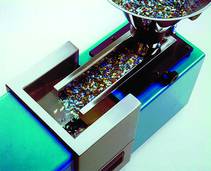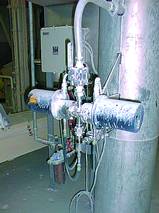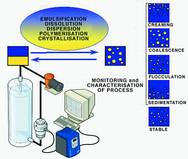
Particulate measurement is critical to the performance of raw materials,intermediates and finished products in over 80% of the worlds manufacturing processes .Fast,reliable and accurate control of particle size gives industries a competitive edge in the research ,development and manufacture of new and established products .New on-line measuring instruments provide direct feedback to affect cost savings and ensure consistant high quality product.

In pharmaceuticals particle size is crucial in tablet and emulsion manufacture and in the efficacy of slow release drugs. The opacity or hiding power of paints is determined primarily by the consistency of the particle size of the chosen pigment. The monitoring of particle size distribution in casting slips is vital in the ceramics industry to ensure repeatable quality porcelain components such as sanitary ware, crockery, drainage etc. Similarly in food and cosmetics particle size is a predictor of taste or smoothness of final products. The strength of cement and cement products is largely determined by the particle size of the powder used and last but by no means least in South Africa the particle size of milled ore is essential in mining to ensure the best possible extraction of the valuable minerals being mined.

In all these industries it is common to take a sample of the product and take measurements routinely from the production line, either at an intermediate point or as a final product. Measurement techniques vary with the industry from sieves to specialised techniques such as the Blaine used by the cement industry.
As any process engineer will know, the longer the delay in the feedback loop the greater the noise on the output and the best response that can be achieved from laboratory measurement runs from hours to days. Often this has lead to indirect measurements being used as control variables in processes. As a result production managers have resisted frequent changes in conditions, demand or product as the set-up times are controlled largely by the time taken to establish the optimum conditions for the new product.

Direct measurement requires no sample preparation and helps to minimise operator error while continuous feedback control works to improve quality, maximise throughput, reduce waste and ensure optimum diagnostic capability.
Many techniques exist for the measurement of particles in process. The optimum one for the task at hand depends primarily on the size of the particle and the medium in which the product is transported.
Mechanical systems have been used for small to medium size particles. While these systems are robust, they rely on the extrapolation of results to predict smaller particle sizes and as such are not entirely reliable in areas where the chemical and physical properties of the product vary.
Large particles, from 1 to 250 mm and above, are typically transported on conveyors and are best measured using optical techniques. In these systems a camera captures images of the product and classifies them as required. On-belt systems are common but suffer from the problem that smaller particles accumulate under the larger ones and being hidden from view are excluded from the analysis. Optical systems are made more accurate when a sample is passed under gravity past a very high-speed image capturing system so that all particles are detected individually. A particular advantage of optical systems is their ability to analyse the shape as well as the size of the individual particles.
For powders and slurries consisting of particles ranging from 0,05 to 3500 æm laser diffraction is the preferred technique. In this technique the particles are passed through a laser beam which is diffracted, into patterns that are proportional to the particle size. These patterns are detected by photo-sensors and translated back to a size distribution in times ranging from a second to a few minutes. Laser diffraction enjoys an unsurpassed reputation for the dynamic range, resolution and reproducibility it brings to particle size measurement.
Slurries are common in many milling applications, particularly mining and carry the material of interest in a concentration of around 30 to 50% solids. As a result such materials require dilution to a level suited to laser diffraction before measurement. This is seldom a problem as the characteristics of the product are not changed by dilution and the additional time taken is small in proportion to the overall system response times. A complete measurement cycle can be completed in as little as 4 min.
A case in point is a local platinum mine. Samples are collected, diluted, measured and analysed automatically and the results fed back to an expert control system which monitors and controls the overall plant operation to maximise the efficiency of the reduction process. The benefits from the system have not been made public but they must be significant, as there is an increasing interest in both the automatic control and the on-line measurement of particle size.
Pneumatically or gravity transported materials have historically proven difficult to measure because either the material or the manufacturing environment or both have been too harsh for sensitive measurement equipment. This has now changed with the introduction of a rugged new industrialised instrument from Malvern Insitec. The instrument can handle even the most abrasive materials such as cement and ferro-silicon. Operating in a bypass mode it uses highly resistant ceramic materials throughout the sampling loop, especially in areas where the potential for erosion is the greatest.
Such a system has been tested at a local cement plant and the process engineers and quality control immediately saw the benefits. Findings reflected overseas experience where the direct measurements required no sample preparation and eliminated operator error while the continuous feedback worked to improve quality control, maximise throughput, reduce waste and ensure optimum diagnostic capability. Not only this but tests have shown that the results from the on-line trials have shown a good correlation with the traditional 'Blaine Test' which measures specific surface area but which is time consuming to perform.
Quantified benefits of on-line particle size measurement show that in a metal powder plant, milling time for a typical batch of material was reduced by over 80% while in a cement plant the time taken to change from one product to another was reduced from 2-3 hours to 1 h. In these cases the time saved in set-up was utilised in full production, increasing output and plant utilisation.
Trials are under way at several other chemical and mineral plants in South Africa as companies seek to gain competitive advantage through optimisation of their processes.
In many cases it is not just particle size that is of interest but also the homogeneity and stability of colloidal dispersions (suspensions, emulsions and foams). In polymers, foods, pharmaceuticals, paints, cosmetics and other industries it is often crucial to study the stability of dispersions in the face of process changes, temperature effects and storage. The tendency for these to emulsify, sediment, cream, dissolve, crystallise or flocculate is of extreme importance in determining the efficacy and shelf life of the product. Techniques for measuring these effects are commonly done off-line and in the case of direct measurement, take a long time, as there is a reliance on subjective assessment. Alternative methods require the dispersions to be diluted which anyway can mask some of the critical effects in the destabilisation process. Once again that has changed with the introduction of a new laser-based instrument which measures the transmission and back scattering (reflection) of the light without having to dilute it first. In the example of creaming of an emulsion the suspended component will tend to rise to the surface over time. This means that the amount of light transmitted through the bottom of the sample will increase over time and the amount of reflection near the surface will increase. Other effects, such as sedimentation, dissolution or flocculation, will be manifested by different combinations of these changes. The major advantages of the automated measurement are that the effects can be detected up to 40 times faster than with the human eye and that different samples can be compared quantitatively.
It is now a matter of experience that on-line particle characterisation proceeds in three stages. In stage one the results of measurement are primarily used by process engineers to assist in characterising the process and fine-tuning the settings and procedures. In the second phase the results are fed back either manually or automatically to allow process adjustments to keep production optimised. Finally the results are accepted for quality assurance release. This last stage is not always the simplest as it takes time for staff and customers alike to gain confidence in the correlation between the tried and trusted methods and the new techniques. In any event the effort required to install and establish the new measurement techniques is soon justified by the improvements in product quality, throughput and reduced costs.
South African process industries now have the opportunity to optimise their production by using a variety of new on-line particle characterisation instruments available to them. These solutions offer higher throughput improved quality, reduced cost, lower wastage and improved diagnostic capability, all necessary attributes in attaining world-class manufacturing standards.
Micron Scientific
(011) 422 4303

© Technews Publishing (Pty) Ltd | All Rights Reserved